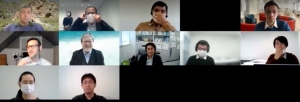

Report on the 13th iPERC Seminar
- 2022/03/18
December 1st, 2021, we had 13th journal club with Dr. Robert V. Warren who is a project scientist at Beckman Laser Institute. For the sake of infection prevention of the COVID-19, it was held online.
In this journal club, four students, two from Shizuoka University and the other two from Hamamatsu University School of Medicine, worked together to make a presentation about a journal paper. The paper selected for this time was published in Nature Medicine entitled “Near real-time intraoperative brain tumor diagnosis using stimulated Raman histology and deep neural networks”.
The paper is about development of automated diagnosis technology for brain tumors, and evaluation of its performance. The proposed method demonstrated near real time diagnosis of brain tumors based on a resected tissue sample during surgery. In order to evaluate the accuracy of the diagnosis, it was compared with a conventional technique in a clinical trial. As a result, it was revealed that the developed method is not inferior to the conventional one.
At the beginning of the journal club, Dr. Warren described this paper as “Doozy” as the study involved many research areas such as photonics, computer science, and clinical study. Although it actually was, students made a great presentation, and it was an exciting journal club.
The word “Brain tumors” refers to tumors developed inside of a cranium. Brain tumors are classified in two groups. One is malignant tumors that have a worse prognosis, and another is benign tumors that can be cured with a surgical operation only. To diagnose brain tumor by conventional techniques, one should resect small tissue during a surgical operation. The resected tissue is then frozen and sliced for the subsequent processes. This sliced frozen tissue is called “Frozen section” and therefore this whole process is called “Frozen section technique”. The slice is then tested by *Hematoxylin-Eosin (H&E) stain or expression assay of various tumor biomarkers. A pathologist diagnoses based on these results. It takes at least 20 to 30 minutes to complete this Frozen section. Together with a fact that we need a pathologist or special equipment for this process, Frozen section has been regarded as time and labor-intensive.
To address that issue, the authors developed a technique that investigate a brain tissue sample to diagnose by using stimulated Raman scattering histology (SRH) and image analysis based on deep learning. SRH is an imaging technique using stimulated Raman scattering light. Stimulated Raman scattering happens when a target is illuminated by laser. The scattering light reflects information of chemical bond of the illuminated target. Therefore, one can understand chemical characters of a target by SRH technique. To have this scattering light, all we need to do is just to illuminate a target by laser. We do not need to process the resected sample as did in the frozen section technique, which leads to saving time.
The authors processed the SRH images by one of the deep learning algorithms, Conventional Neural Network (CNN). CNN is a type of image analysis technique that is based on deep learning. The authors could estimate the type of tumor included and the margin between the tumor and normal tissue. The algorithm employed in this study included functions that simplify the computation for a complicated tissue image, reduce learning time of the CNN to discern a tumor accurately and allow users to analyze rare tumors, too. In general, the internal process in CNN tends to be hidden in a “Black Box”, but this study overcame the issue by a method to extract and visualize characters that CNN is focusing on to discern pathological state.
This method was tested in a clinical trial in which 278 patients were participated. The inferiority of the proposed method was evaluated against the conventional pathological diagnosis. As a result, the authors could not statistically conclude that the proposed method was inferior to the conventional method in terms of the accuracy of its diagnosis. However, the proposed method achieved to save time to diagnose from 20 to 30 minutes to around 2.5 minutes. This result indicates that it is possible to diagnose a tumor without the presence of a trained pathologist or specialized clinical tools. It means that it should mitigate the intensive labor that have been taken for brain tumor diagnosis. This method can be employed as a backup diagnosis along with the conventional pathological method. This proposed method has been commercialized by a startup company, Invenio Imaging inc. in the United States. Dr. Warren mentioned that he hopes this research will be a tool that is available to many surgeons all across the globe.
While the presentation was going through, discussion was made between the audiences and the presenters as shown below.
Question: Is it possible to use this technique without resecting tissue, in situ?
Answer: I think it is possible. But, we should need improvement that hold the accuracy achieved in that way of usage. For example, movements of patients or bleeding should be noise for the image analysis of CNN, which might harm the diagnosis accuracy.
Question: Why are the SRH images shown in colors of green and pink?
Answer: This is to make the SRH images look similar to conventional H&E images in which cellular compartments shown in green and pink. By using these pseudo colors, pathologists and surgeons feel familiar to the SRH images.
Question: Could you explain more about the “non-inferiority trial” used in this research?
Answer: It is a statistical method to test whether diagnosis accuracy of a method is inferior to that of another method. By using this method, we can determine whether the proposed method is inferior to the conventional method as long as the either accuracy is less than 91%. In other words, if both of the methods show more than 91% of accuracy, we cannot say one is inferior to the other. As a result, the authors could not say that the proposed method was inferior to the conventional method.
Question: I understand that the proposed method showed almost same diagnosis accuracy compared to the convectional one. So, what is the advantage of the proposed method?
Answer: The proposed method does save time to diagnose. In case of the conventional method, it takes 20-30 minutes, but the proposed method requires only 2.5 minutes, which makes this technique useful. I think the diagnosis accuracy should be improved by adding a function that is able to discern molecular biomarkers of brain tumors in their future development.
Question: Could you tell me how large the training data is and how long the training takes?
Answer: 2.5 million image patches (A patch is a compartmented image from an originally acquired SRH image) were used for the training. The training data was acquired from 415 patients. The training was repeated for 10 cycles.
Question: How long does it take to image a resected sample and analyze it?
Answer: It takes about 2 minutes. Since it requires some time to take the images, it should be difficult to use in situ. There should be noises from the patient’s movement for example. CNN might have difficulty to diagnose accurately using that noisy SRH images.
Dr. Warren also asked students, “What was the most exciting or impressing thing while you studied this paper?”. Students answered, “I was impressed by that every procedure to diagnose was done inside of an operation room and greatly reduced the time and labor.”, “I was enjoying to study Raman spectroscopy and CNN that are new things to me. I was also impressed by the video showing that this technology was engaged in real operation.”, “What I found interesting is the authors visualized what the CNN is doing inside of the computation, which makes the interpretability improved.”, and “I was impressed by that the SRH image is quite similar to the conventional H&E image. I think by using this technique, it is possible to do remote operation or to do operation in emergent cases where trained pathologist is absent.”.
Dr. Warren asked Prof. Dr. Seiji Yamamoto who is also a neurosurgeon, about his opinion of this development. He said, “It is very important to discern **malignant glioma and ***gliosis. Finding margin of tumor is also important. It is especially difficult to remove malignant glioma in an operation completely since the margin is difficult to locate. So, it is wonderful if we can locate the margin in real time during an operation because it does contribute to elongate 5-year survival rate of patients. While I was listening to this club, I thought we can achieve it in near future. In that sense, it was very interesting.”
The author of this report is doing microscopy research as my Ph.D. thesis research. Raman microscopy technique is now blooming in microscopy research area, and I have seen many articles published in recent years. I am not that familiar with CNN or Deep Learning things, but I know it is one of the hottest research areas in this era in academia and industry too. I also have seen that many collaboration research works between top-notch technologies in different areas as was shown in this paper. I think collaborations in clinical studies especially important since researchers can meet many different researchers who are working on different things and one can find new ideas for their own work through the collaborations. Needless to say, it does contribute to patient’s benefit with the invented technologies. I hope the next innovation will come out from the collaborations and hopefully I would like to be part of it. As Dr. Warren mentioned at the beginning, the paper was actually complicated or doozy. But the students studied and prepared so well for this journal club, and the presentation and Q&A were clear and exciting. Dr. Warren seems a humble, gentle, and friendly person, and that made the atmosphere of the journal club nice. I am looking forward to participating the next journal club with enough pre-study to have discussion with the wonderful presenters and audiences.
A snapshot from the journal club
A small glossary
*Hematoxylin-Eosin (H&E) stain
A cellular staining method to distinguish the cellular nucleus and cytoplasm. Nucleus is stained in blue color and the cytoplasm is in red color.
Reference:http://www.labo.city.hiroshima.med.or.jp/wp-01/wp-content/uploads/2015/01/center201502-02.pdf (Accessed: 11th, January 2022)
**Malignant glioma
Tumors originated from glial cell that is in brain and myelon, can be classified in one of four groups based on its malignancy. Malignant glioma is tumors classified in the grade of 3 or 4.
Reference: https://www.ims.u-tokyo.ac.jp/glioma/tumor/glioma.html (Accessed: 11th January 2022)
***Gliosis
Gliosis is a phenomenon that the number of astrocytes is increasing in the presence of inflammations in brain or myelon.
Reference: https://www.qst.go.jp/site/qms/1653.html (Accessed: 11th January 2022)
innovative Photonics Evolution Research Center (iPERC)
3-5-1 Johoku, Chuo-ku, Hamamatsu, Shizuoka 432-8011 Japan
phone: +81-53-478-3271 / fax: +81-53-478-3256
